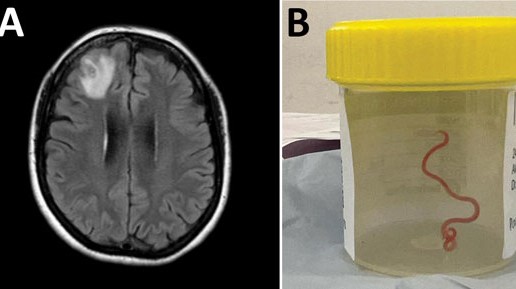News release
From:
Aussie woman found with parasitic roundworm in her brain caught from carpet python
Forget snakes on a plane; it’s snake parasites in a brain!
The world’s first case of a new parasitic infection in humans has been discovered by researchers at The Australian National University (ANU) and the Canberra Hospital after they detected a live eight-centimetre roundworm from a carpet python in the brain of a 64-year-old Australian woman.
The Ophidascaris robertsi roundworm was pulled from the patient after brain surgery – still alive and wriggling. It is suspected larvae, or juveniles, were present in other organs in the woman’s body, including the lungs and liver.
“This is the first-ever human case of Ophidascaris to be described in the world,” leading ANU and Canberra Hospital infectious disease expert and co-author of the study Associate Professor Sanjaya Senanayake said.
“To our knowledge, this is also the first case to involve the brain of any mammalian species, human or otherwise.
“Normally the larvae are found in small mammals and marsupials, which are eaten by the python, allowing the life cycle to complete itself in the snake.”
Ophidascaris robertsi roundworms are common to carpet pythons. The roundworm typically lives in a python’s oesophagus and stomach, and sheds its eggs in the host’s faeces. Humans infected with Ophidascaris robertsi larvae would be considered accidental hosts.
Roundworms are incredibly resilient and able to thrive in a wide range of environments. In humans, they can cause stomach pain, diarrhoea, appetite and weight loss, fever and tiredness, as well as intestinal problems leading to severe pain and vomiting.
The researchers say the woman, from southeastern New South Wales in Australia, likely caught the roundworm after collecting a type of native grass, Warrigal greens, beside a lake near to where she lived in which the python had shed the parasite via its faeces.
The patient used the Warrigal greens for cooking and was probably infected with the parasite directly from touching the native grass or after eating the greens.
She was first admitted to a local hospital in late January 2021 after suffering three weeks of abdominal pain and diarrhoea, followed by a constant dry cough, fever and night sweats. By 2022, the patient was experiencing forgetfulness and depression, prompting an MRI scan.
A neurosurgeon at Canberra Hospital found an abnormality in the right frontal lobe of the brain. Neurosurgery was performed to explore the abnormality. It was then that the doctors made the unexpected finding or the live and wriggling eight-centimetre roundworm. Its identity was later confirmed through parasitology experts, initially through its appearance and then through molecular studies.
Associate Professor Senanayake said the world-first case highlighted the danger of diseases and infections passing from animals to humans, especially as we start to live more closely together and our habitats overlap more and more.
“There have been about 30 new infections in the world in the last 30 years. Of the emerging infections globally, about 75 per cent are zoonotic, meaning there has been transmission from the animal world to the human world. This includes coronaviruses,” he said.
“This Ophidascaris infection does not transmit between people, so it won’t cause a pandemic like SARS, COVID-19 or Ebola. However, the snake and parasite are found in other parts of the world, so it is likely that other cases will be recognised in coming years in other countries.
“The other message from this case is about foraging. People who forage should wash their hands after touching foraged products. Any foraged material used for salads or cooking should also be thoroughly washed.”
The patient continues to be monitored by the team of infectious disease and brain specialists.
“It is never easy or desirable to be the first patient in the world for anything. I can’t state enough our admiration for this woman who has shown patience and courage through this process,” Associate Professor Senanayake said.
The researchers’ findings have been described in the journal Emerging infectious diseases.
The research team included scientists and infectious disease, immunology and neurosurgical doctors from ANU, Canberra Health Services, CSIRO, the University of Melbourne and the University of Sydney.
Multimedia




 Australia; NSW; ACT
Australia; NSW; ACT



